Recycled glass jars can work fine when you start fermenting vegetables (aka DIY pickling).
However, when you start making larger batches of ferments (like huge batches of sauerkraut or pickles) or want to “set it and forget it,” you’ll want to upgrade to a fermentation crock.
Here’s what you need to know about choosing the best fermenting crock.
What Is a Fermentation Crock?
Fermentation crocks are pots that are made for fermenting. Traditionally, they are made from ceramic, but lately, I’ve seen some glass fermenting crocks on the market. Fermenting pots come in various sizes, ranging from 2 to 40 liters.
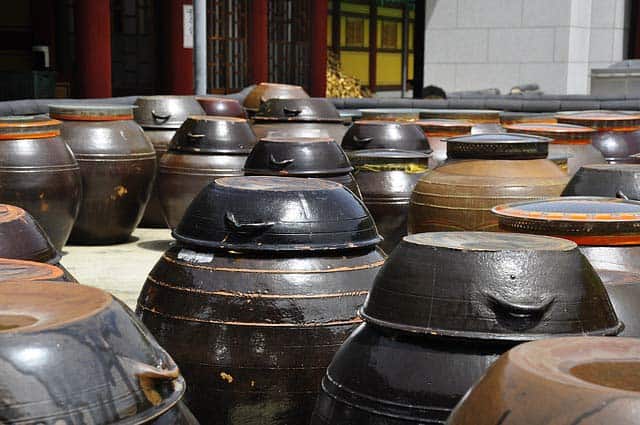
Advantages of Fermenting Crocks
When I first started making ferments, I just used glass jars. I still think these are fine for beginners to use. But then I tried a batch of kraut my friends made in a German-style fermenting crock.
Their kraut was a heck of a lot better than anything I’d made. It wasn’t just a matter of the recipe or expertise; ferments come out better in a crock for two main reasons:
- Crocks Have Thick Walls: The thick walls on ceramic pickling crocks act as natural insulators, keeping the brine temperature stable. This allows the bacteria to work better and produces better results.
- Dark Environment: UV light kills the healthy bacteria in your ferment brine. This isn’t such a big deal for short-term ferments. However, if you want a vintage slow-ferment or to store your ferments for a longer time, you’ll want a fermenting crock that protects from the light.
In addition to these benefits, fermentation crocks are simply more beautiful to look at and use. This doesn’t affect the taste, but it makes fermenting a more enjoyable experience. I like looking at the ceramic fermenting crocks on my shelves.
Types of Fermentation Crocks
There are two main types of Lacto-fermentation pickling crocks: Open crocks and water-seal fermentation crocks. Both work better than glass jars because of their thicker walls and dark environment. However, water-seal crocks are the definite winner.
Open Fermenting Crocks
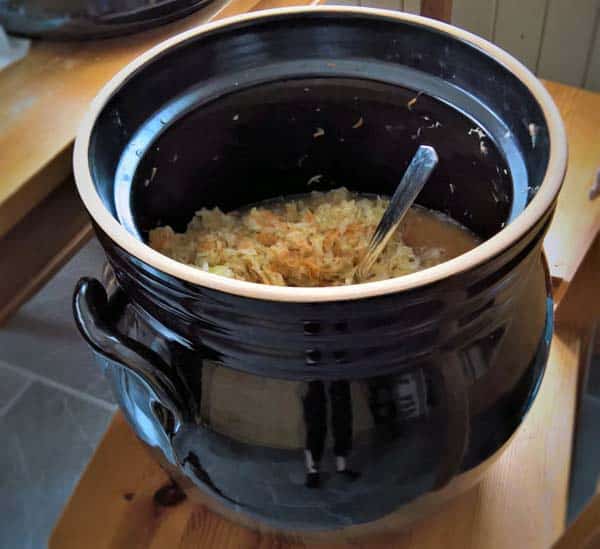
These are the traditional style of fermenting crocks. They are just big ceramic pots with weights that fit inside of them.
To use an open crock, you just put the food and brine into the pot (leaving a bit of headspace to allow for expansion). Then you weigh the food down so it remains under the brine. The crock is then covered with a cloth to keep pests out but still allow gas from the fermentation process to exit.
IMO, open crocks aren’t that much better than using jars. Because they are left open, they can get over-exposed to oxygen. Molds and bacteria can land on the ferment. Usually, this results in a harmless white film on top of the brine (which you can skim off).
However, sometimes more harmful contaminants make it onto the brine – like insect eggs. You could end up with harmful bacterial contamination, that nasty green or black mold that occurs on top of ferments.
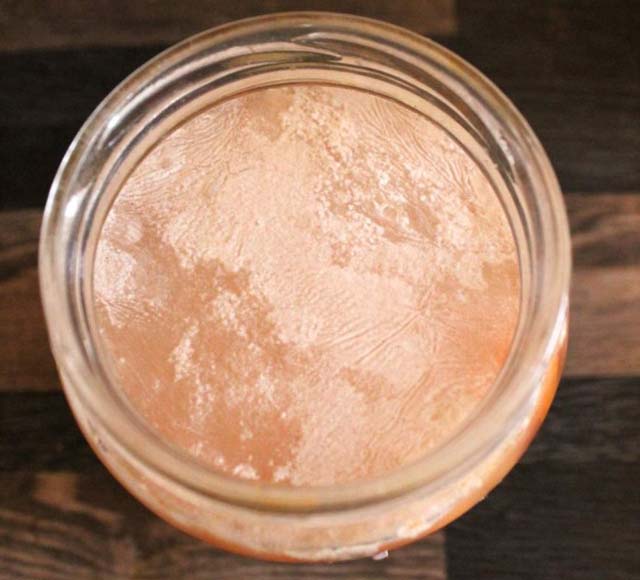
You are more likely to have problems with open crocks and could end up tossing entire batches. Some open crocks come with lids. This beats covering the crock with a cloth but doesn’t prevent contamination completely.
Open Crocks
Affordable
Easy to clean
Can fit entire large vegetables into them
More prone to contamination
Water-Sealed Fermentation Crocks
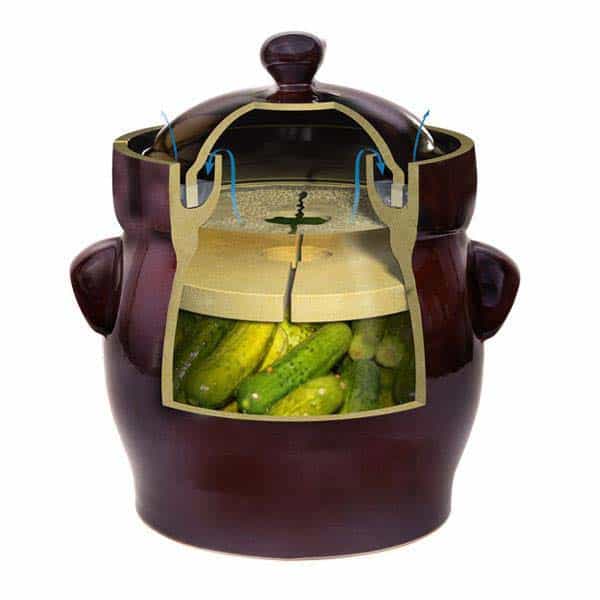
These are what hardcore fermenters use. You load them up and weigh the food down, just like any other fermenting jar or crock. The difference is that they have a “moat” around the top which you fill with water. Then you put the lid in place.
The water creates a seal so outside oxygen cannot get into the fermenting crock. The lid prevents contaminants like insects, mold, and bacteria from getting onto the brine. However, the carbon dioxide gases created from the fermenting process can still escape through the water seal, so there is no risk of explosion (which can occur if you put a lid tightly on a fermenting jar!).
Because of this design, there is almost zero risk of contamination. You won’t see any nasty white film on top of the ferment. You can make bigger batches of ferments without worrying about having to toss an entire batch.
You can even store these ferments in a basement or root cellar. The sealed design will prevent them from picking up musty smells. This isn’t the case with open fermenting crocks. While they may still be safe to eat, it isn’t pleasant to eat pickles that taste like your basement.
The only downside is that you must keep water on the seal. If it’s hot out, the water might evaporate pretty quickly. Also, note that some water-sealed crocks have weird shapes, which can be annoying to pack and clean.
Water Sealed
Incredibly easy
Very little chance of mold or bacterial contamination
Insects can’t get to ferments
Don’t pick up outside smells, tastes, and odors
Must keep seal filled
Shape makes them harder to clean
Tend to be pricey
What about Airlock Lids for Jars?
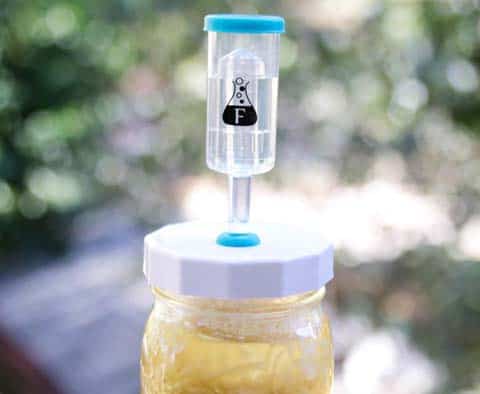
If you don’t feel like investing in a fermenting crock for your pickles yet but still want better results, consider getting air-lock lids for your jars.
Remember that fermenting works best in an oxygen-less environment. You also don’t want bacteria and mold from the air to land on your ferments. But, if you tightly cover the ferments, gas won’t escape, and the jar can explode.
Airlock lids (like these on Amazon) solve this problem.
They are designed so gases can escape, but outside air cannot enter. This removes almost all risk of contamination (which is why I prefer airlock lids over open fermenting crocks). However, airlock lids won’t protect your ferments from UV light nor help control temperature. Water-seal crocks are still the best choice for serious lacto pickling.
Choosing Fermenting Crocks
IMO if you are going to invest in a fermenting crock, it should be a water-seal crock. Yes, these are pricier than open crocks – but they eliminate the risk of contamination. You won’t be forced to toss entire batches of ferments and will save yourself a big headache.
Here are some things you need to consider when choosing a fermenting crock.
Sizing
The most important thing to consider is the size. The size affects how easy it is to use and how much you can pickle at once.
Capacity
In most cases, the fermenting crock’s capacity refers to how many liters of kraut you can make in it. The crock will be much larger because of the space needed for brine, the weight, and the headspace.
However, with some crocks (like Harsch crocks), the capacity refers to its actual size. You won’t be able to make 10 liters of kraut in a 10-liter Harsch crock. Realistically, you’ll get around 6 liters in a 10-liter crock.
Most people will probably want a 5 or 10-liter crock. Remember that veggies shrink after fermenting, so the yield is smaller than what you stuffed into the crock.
- 5 liters (1.3 gallons): Fits around 10lbs of cabbage; yields 10-14 pints
- 10 liters (2.6 gallons): Fits around 20lbs of cabbage; yields 20-28 pints
*Don’t forget that fermenting crocks must be filled almost to the top to eliminate excess air. So don’t buy a crock which is too big.
Will it fit in your sink?
Even if you make huge batches of ferments, large crocks can be painful to clean (especially if they can’t fit in your sink!). Consider this before getting a huge pickling pot.
Can you lift it?
Fermenting crocks are heavy when filled (a 10-liter crock is about 28lbs when empty!). If you have a bad back or need to move your ferments far, don’t get anything bigger than a 10-liter crock.
Material
While some fermenting crocks are made of glass, you are best off getting one made from ceramic.
Ceramic protects the ferments from UV light (which kills the healthy fermenting bacteria). It also acts as an excellent insulator for temperature control.
Avoid plastic fermenting buckets. They don’t produce great results, and chemicals from the plastic (even BPA-free buckets) can leach into the ferments.
Best Fermenting Crocks
When it comes to fermenting crocks, a handful of brands make beautiful ceramic pots. You really can’t beat these for vintage-style sauerkraut and ferments.
Many of these crocks are made in Poland or Eastern Europe (where traditional fermenting is still part of everyday life). So, the shipping costs can be a bit crazy. Luckily, the major brands have US distributors, so you can even find many of them on Amazon Prime with free shipping.
Ohio Stoneware
Ohio Stoneware is a ceramics company based out of Zanesville, Ohio. As a former native of Ohio, I even visited them when I was a kid. So, I guess I have a soft spot for them.
Personal biases aside, Ohio Stoneware makes excellent products.
The design of their crocks is white with blue stripes, which suits country-inspired kitchens. IMO, it’s more attractive than the brown fermenting crocks. The cylindrical shape makes them easy to clean.
The water-seal fermenting crocks have three pieces: the crock, a weight, and a lid.
TSM Harvest Fiesta Crock
TSM is a company based out of Buffalo, NY. However, note that their fermenting crocks are made in China. Because of this, they are a bit more affordable than other crocks.
Being made in China doesn’t seem to affect their quality. They are really popular, and people love them.
There are several styles of fermenting pots made by TSM. All have water seals and come with the crock, weight, and lid. I would recommend the Fiesta-style crock.
It has a straight-down channel, which makes it easier to load entire vegetables. It’s also easier to clean afterward. The deep groove holds lots of water, so you won’t have to refill it as often. The crock is available in larger sizes (up to 20 liters).
Polish Pottery
These are stunning if you want a beautiful fermenting crock (or want to get one for someone as a gift). They are handmade and painted in a small town in Poland. The quality is superb: they don’t crack or break easily and can even be put in the microwave or dishwasher.
They are surprisingly affordable, too (at least some of the options).
K&K Keramik Kerazo
This company is based out of Germany, and, yes, the crocks are made in Germany (not in China).
The crocks are handmade and colored with an earthy brown color. There’s a sizeable handle on the sides of the crocks to make it easier to pick up.
The crocks all come with a weight and a lid. There are three sizes available; we link to the 7 liter here.
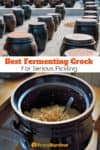






Diane, I believe I’ve inherited a pickling crock or fermenting crock I can find pics of the crock on online shops but no recipes. Can you help? I’m thinking it would be like the chinese pickling crocks. I just don’t know if use salt water or regular. I would really appreciate some help.
Just follow the same instructions for fermenting. It doesn’t matter if you are using a glass jar or ceramic crock. The real benefit of the crocks is that they do a much better job of holding the food under the brine. I personally hate the “weigh the food down with a rock” method!